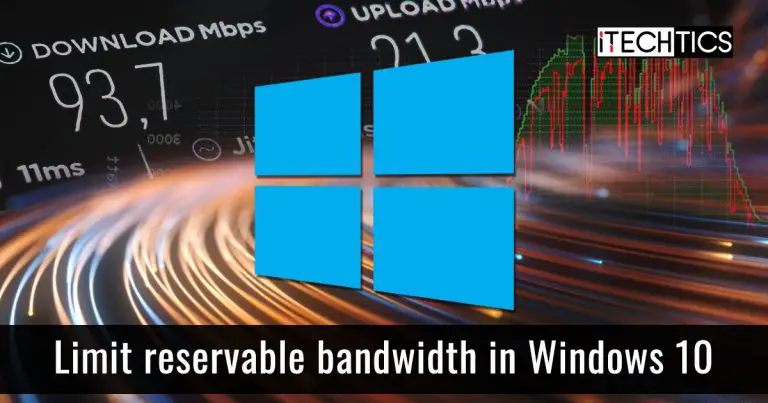You might not know this, but any device with Windows 10 as its operating system limits your network usage by capping its bandwidth at a maximum of 80 percent. This is why you might get slow internet speeds while downloading files off of the internet.
This article discusses two different ways through which you can remove this limit and get the maximum download speeds on your computer.
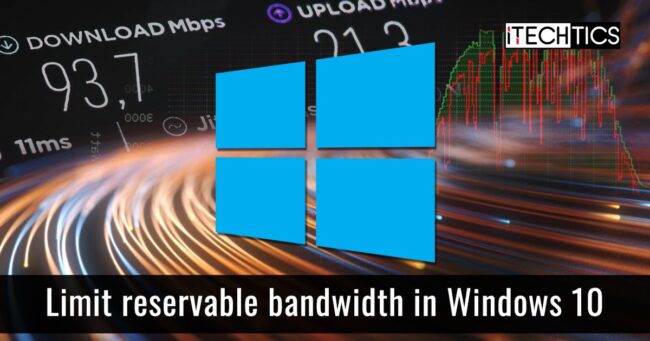
Table of Contents
Reason for limiting bandwidth
Bandwidth, by definition, is the amount of data transferred between source and destination in a limited time frame. Therefore, bandwidth is always measured in Megabytes per second (Mbps), or Gigabytes per second (Gbps).
Windows then limits the usability percentage of the available bandwidth so that all of it is not consumed by the functions that we (users) are performing, while the remaining 20 percent is reserved for critical system-related tasks, such as Windows updates, license renewals, etc.
Windows does not reserve this bandwidth out of spite, but only to ensure that it performs its critical tasks on priority in case they require communication over the internet, while you are still downloading/uploading large files.
Note: Even though the cap is set, it does not mean that the overall bandwidth usage by the applications and programs cannot exceed 80 percent of the available internet speed. The 20 percent of the reserved bandwidth is only made available when explicitly requested by a priority task. However, if there isn’t a critical task being executed that requires this reserved 20 percent bandwidth, it can be used for regular tasks.
How to limit reservable bandwidth in Windows 10
You can remove this bandwidth limiter in Windows 10 using any of the two methods mentioned down below. But we must warn you at this point that removing this limit would result in system-critical tasks not being able to communicate over the internet if the whole bandwidth is being used. Hence, we would recommend that you still leave some reserved bandwidth for such operations.
Limit reservable bandwidth from Group Policy
Group Policies allow us to manage and control how our operating system behaves. You can use the Group Policy Editor to remove or limit your reservable bandwidth.
- Launch the Group Policy Editor by typing in gpedit.msc in Run.
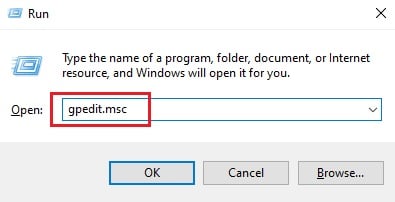
- Now navigate to the following location using the left pane:
Computer Configuration -> Administrative Templates -> Network -> QoS Packet Scheduler - Now double-click Limit reservable bandwidth in the right pane.

- Perform one of the following to either change the limit or turn off the reservable bandwidth altogether:
- Change limit: Select the Enabled radio button, then set the Bandwidth limit (%) between 1 and 100 under the Options category. Click on Apply and Ok when done.
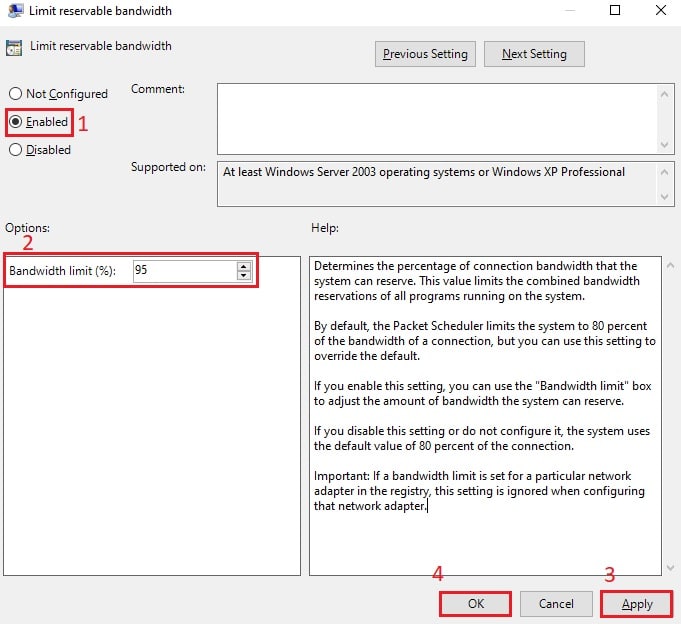
- Turn off reservable bandwidth: Select the Enabled radio button, then set the Bandwidth limit (%) to 0 under the Options category. Click on Apply and Ok when done.
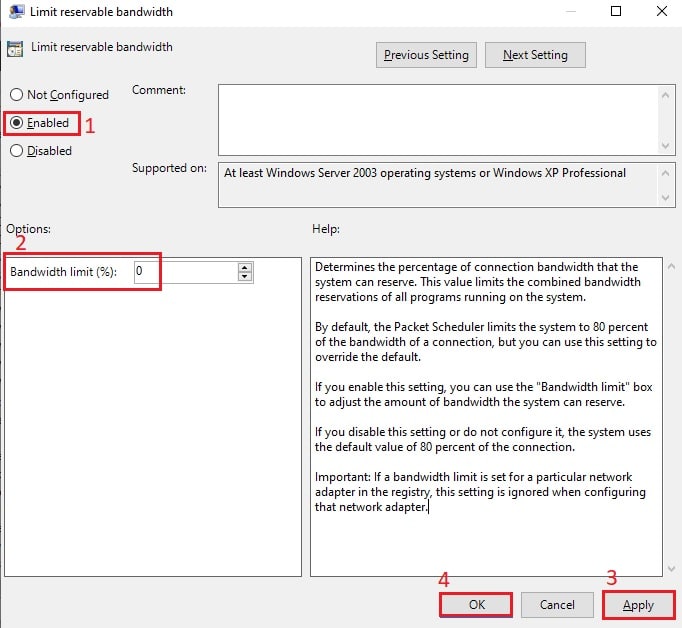
Note: Selecting the Disabled radio button would bring the limit back to 80 percent which is its default value. Therefore, enter 0 to turn the feature off.
- Change limit: Select the Enabled radio button, then set the Bandwidth limit (%) between 1 and 100 under the Options category. Click on Apply and Ok when done.
- Now launch Command Prompt and enter gpupdate /force to enforce the changes made to the Group Policy.
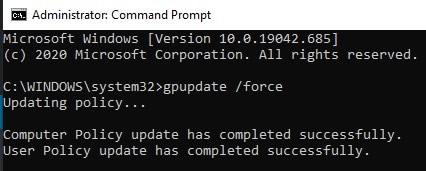
The new settings will now be applied. You may now notice a difference in download speeds when downloading larger files from the internet.
Limit reservable bandwidth using Registry Editor
You can also limit the reservable from the Registry Editor. We must warn you that manipulating the system registries can turn fatal for your operating system. Therefore, we recommend that you create a restore point before proceeding forward.
- Launch the Registry Editor by typing in regedit in Run.
- Now navigate to the following from the left pane:
HKEY_Local_Machine -> Software -> Policies -> Microsoft -> Windows - Now right-click Windows, expand New, then click Key.

- Name this new key as Psched.
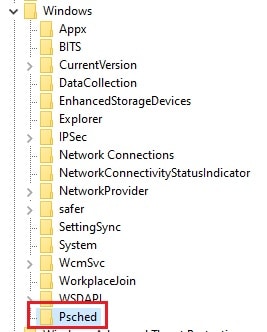
- Now right-click Psched, expand New, and then click DWORD (32-bit) Value.
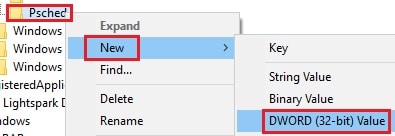
- Name this new DWORD as NonBestEfforLimit.

- Double-click the new DWORD, select the Decimal radio button and then enter the percentage for the bandwidth limit under Value data between 1 and 100. You can also enter 0 to turn the feature off entirely.
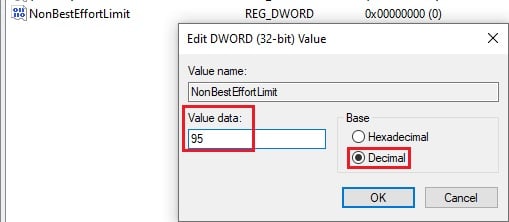
Click Ok when done. - Now restart your computer for the changes to take effect.
You have now successfully changed the reservable bandwidth limit on your device.
Closing words
As mentioned earlier, changing the limit to a full 100 percent might not be the wisest decision. However, it would be alright to temporarily remove the limit to perform speedy downloads.
Having said that, you can always reverse your settings by either selecting Not configured from the Group Policy or deleting the Psched key from the Registry Editor, depending upon which method you chose to change the limit for the reserved bandwidth in the first place.

